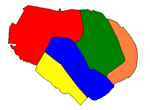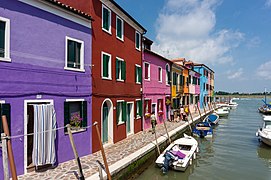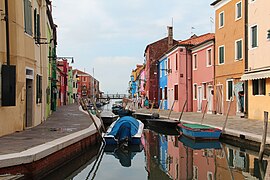geo.wikisort.org - Island
Burano is an island in the Venetian Lagoon, northern Italy, near Torcello at the northern end of the lagoon, known for its lace work and brightly coloured homes. The primary economy is tourism.[1]
This article needs additional citations for verification. (September 2017) |
 View of Burano from Mazzorbo | |
 Burano | |
| Geography | |
|---|---|
| Coordinates | 45.485771°N 12.417487°E |
| Adjacent to | Venetian Lagoon |
| Area | 210,800 m2 (2,269,000 sq ft) |
| Highest elevation | 1 m (3 ft) |
| Administration | |
Italy | |
| Comune | Venice |
| Demographics | |
| Population | 2,777 |
Geography
Burano is 7 kilometres (4 miles) from Venice, a 45-minute trip from St. Mark's Square by vaporetto, a Venetian water bus.
The island is linked to Mazzorbo by a bridge.[2] The current population of Burano is about 2,400. Originally, there were five islands and a fourth canal that was filled to become via e piazza Baldassare Galuppi, joining the former islands of San Martino Destra and San Martino Sinistra.
Burano has historically been subdivided into five sestieri, much like Venice. They correspond to the five original islands. The sixth sestiere is neighboring Mazzorbo:
| Sestiere | Area[3] | Population | Density | Map | |
| San Mauro | 6.8 ha | 818 | 12,029 |  | |
| Giudecca[4] | 2.5 ha | 255 | 10,200 | ||
| San Martino Sinistra | 4.4 ha | 586 | 13,318 | ||
| San Martino Destra | 5.1 ha | 759 | 14,882 | ||
| Terranova | 2.3 ha | 359 | 15,609 | ||
| Burano (Island) | 21.1 ha | 2,777 | 13,176 | ||
| Mazzorbo[5] | 51.8 ha | 329 | 635 |
Burano has a high population density, calculated at more than 13,000 per square kilometer, or more than twenty times the density of neighboring Mazzorbo. It is almost entirely covered by residential buildings, with few small green areas.
History
This section does not cite any sources. (September 2017) |


The island was probably settled by the Romans, and in the 6th century was occupied by people from Altino, who named it for one of the gates of their former city. Two stories are attributed to how the city obtained its name. One is that it was initially founded by the Buriana family, and another is that the first settlers of Burano came from the small island of Buranello, about 8 kilometres (5 miles) to the south. [citation needed]
Although the island soon became a thriving settlement, it was administered from Torcello and had none of the privileges of that island or of Murano. It rose in importance only in the 16th century, when women on the island began making lace with needles, being introduced to such a trade via Venetian-ruled Cyprus.[6] When Leonardo da Vinci visited in 1481, he visited the small town of Pano Lefkara and purchased a cloth for the main altar of the Duomo di Milano. The lace was soon exported across Europe, but trade began to decline in the 18th century and the industry did not revive until 1872, when a school of lacemaking was opened. Lacemaking on the island boomed again, but few now make lace in the traditional manner as it is extremely time-consuming and therefore expensive. [citation needed]
Main sights

Burano is also known for its small, brightly painted houses,[7] which are popular with artists. The colours of the houses follow a specific system, originating from the golden age of its development. If someone wishes to paint their home, one must send a request to the government, who will respond by making notice of the certain colours permitted for that lot.[8]
Other attractions include the church of San Martino, with a leaning campanile and a painting by Giambattista Tiepolo (Crucifixion, 1727), the Oratorio di Santa Barbara and the Museum and School of Lacemaking.[9]
Transport
The island forms part of the Actv waterbus network. The following lines connect to Burano:
9 (Burano-Torcello)
12 (Fondamente Nove-Murano-Burano-Treporti-Punta Sabbioni)
14 (S.Zaccaria-Lido SME-Punta Sabbioni-Burano)
A night service also operates.
Gallery
- Rio della Giudecca
- Rio di Terranova
- Rio del Pontinello
- Nearly all buildings are painted in rich colors
- A lonely house in a residential area
- Contrasting colours of adjacent houses
- Entrance of a house in Fondamenta degli Assassini
- View on a canal at dawn
See also
References
- Academy, Students'. Venice- Queen of the Adriatic. ISBN 9781435774681.
- Mather, Victoria (26 July 2012). "Discovering an Italian Retreat". Vanity Fair. Retrieved 25 April 2017.
- Relative area portions measured from map.
- Not to be confused with Giudecca in the sestiere Dorsoduro of the historic center of Venice.
- Neighboring island (not on map).
- "Colorful Burano worth a side trip — by water — from Venice". Tampa Bay Times. 2016-12-14. Retrieved 2019-06-20.
Local women began making lace in the 16th century after merchants brought back needles from Venetian-controlled Cyprus, where the skill already flourished.
- Christofi, Dora (26 August 2015). "Murano & Burano: The Venetian lagoon Islands". Trip-experiences.com. Retrieved 25 April 2017.
- Strutner, Suzy (5 November 2013). "Burano, Italy Is The Cheeriest Little Island, And It Will Lift Your Soul On Travel Tuesday". Huffington Post. Retrieved 25 April 2017.
- "Venice Lace Museum Official Website". visitmuve.it. Retrieved 25 April 2017.
External links
 Media related to Burano at Wikimedia Commons
Media related to Burano at Wikimedia Commons
На других языках
[de] Burano
Burano, venetisch Buran, ist mit einer Fläche von mehr als 21 ha eine der größeren und mit über 2700 Einwohnern eine der am dichtesten besiedelten Inseln in der Lagune von Venedig. Burano liegt nordöstlich des historischen Zentrums von Venedig. Eigentlich handelt es sich um eine Gruppe von vier, früher fünf nahe beisammenliegenden und durch acht Brücken verbundenen Inseln.- [en] Burano
[es] Burano
Burano (en veneciano Buran 1 y ocasionalmente Buràn) es una isla de la laguna de Venecia, situada a 7 kilómetros de Venecia, Italia, distancia que se recorre en 40 minutos en vaporetto. Su población actual ronda los 7000 habitantes.[fr] Burano
Burano est une île du nord de la lagune de Venise, en Italie. Elle est connue pour sa dentelle et ses canaux bordés de maisons vivement colorées.[it] Burano
Burano (Buràn [buˈraŋ] in veneto) è un centro abitato di 2 270 abitanti che sorge su quattro isole della laguna di Venezia settentrionale. Fa parte del comune di Venezia e in particolare della municipalità di Venezia-Murano-Burano. È collegato da un ponte all'isola di Mazzorbo, che ne è divenuta una sorta di appendice. La cittadina è nota per le sue tipiche case vivacemente colorate e per la secolare lavorazione artigianale ad ago del merletto di Burano. Notevoli sono le tradizioni gastronomiche; tipici dolci sono i bussolai. Fino al 2005 fu sede del quartiere 6 Burano-Mazzorbo-Torcello, abolito con l'istituzione delle odierne municipalità[1].[ru] Бурано
Бура́но (итал. Burano, вен. Buran) — островной квартал Венеции, расположенный на удалении 7 км от центра города, рядом с островом Торчелло, с населением 2724 жителя (2011). Известен своими ярко окрашенными домами.Другой контент может иметь иную лицензию. Перед использованием материалов сайта WikiSort.org внимательно изучите правила лицензирования конкретных элементов наполнения сайта.
WikiSort.org - проект по пересортировке и дополнению контента Википедии







